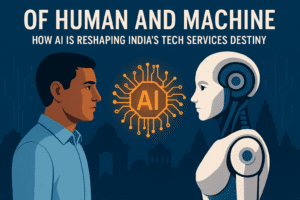Of Human and Machine: How AI is Reshaping India’s Tech Services Destiny
A new Nasscom-McKinsey report positions AI not as a replacement for India’s tech talent, but as its essential partner, heralding a future of human-AI collaboration. While near-term growth may slow as budgets shift toward AI, this transition unlocks a massive $300-500 billion new opportunity in agentic AI. The industry’s core will transform, compressing legacy services but expanding data and AI segments. Success hinges on moving from selling hours to selling AI-powered outcomes, requiring a fundamental reset in talent and business models.
India’s unparalleled scale of tech talent and reskilling capability offers a unique generational advantage to lead this change. However, converting this potential into global leadership demands bold investments in proprietary IP and new delivery frameworks. The future of tech services will be defined by hybrid teams that combine human expertise with AI’s scale, setting a new global benchmark for innovation and value.

Of Human and Machine: How AI is Reshaping India’s Tech Services Destiny
A new chapter is beginning for India’s legendary technology services sector. For decades, the industry has been the engine of the global digital economy, built on a foundation of unparalleled human talent and scale. But according to a landmark new report by Nasscom and McKinsey & Company, its future will be defined by a powerful new partnership: the convergence of human expertise and artificial intelligence.
The report, “Future of Technology Services: Leading with AI,” suggests we are not merely witnessing an industry upgrade, but a fundamental reimagination of what the sector can be. The question is no longer if AI will change everything, but how India will lead that change.
Beyond Automation: The Rise of the Hybrid Team
The past narrative of AI in tech services often centered on automation and cost-cutting—a story of machines replacing tasks. This report pivots from that entirely. The next era is about collaboration, not replacement.
Imagine a future where:
- Software developers don’t code alone but are amplified by AI co-pilots that handle routine code, identify bugs, and suggest optimizations, freeing them to solve more complex architectural problems.
- Data analysts are partnered with AI agents that can instantly synthesize millions of data points, surface hidden insights, and generate predictive models, allowing the human expert to focus on strategic interpretation and business storytelling.
- Customer support transforms from a scripted call center into a seamless flow between AI agents handling Tier-1 queries and human agents, pre-briefed by AI, stepping in for empathy, nuance, and complex issue resolution.
This “human plus AI agent” model is the core of the shift. It promises not just efficiency, but a new benchmark for speed, scale, and—crucially—trust.
The Financial Picture: Near-Term Pressure, Long-Term Promise
The report is candid about the road ahead. Growth is projected to be muted in the immediate future (around 5-7% over five years), with a full recovery not expected until 2027-2030. Why?
Enterprises are recalibrating. They are shifting budgets away from traditional legacy service lines and toward AI-driven initiatives. This will create near-term compression as providers make forward commitments on productivity gains. It’s a period of investment and transition.
However, this short-term pressure unlocks a staggering long-term opportunity. The analysis identifies a $300-500 billion new spend pool that can be unlocked by “Agentic AI”—AI that can autonomously execute multi-step processes towards a goal. This isn’t just a new tool; it’s a new market.
India’s Unique Moment: Advantages and Imperatives
The report argues that India is uniquely positioned to lead this transformation, but it must act decisively. Its advantages are clear:
- Talent Scale: The world’s largest pool of tech talent.
- Reskilling Velocity: A proven, rapid ability to train and upskill massive workforces.
- Global Capability Centers (GCCs): These are evolving from back-office support hubs into high-impact innovation centers for global enterprises, deepening India’s integration into core R&D.
Yet, advantages are not guarantees. To seize this “once-in-a-generation opportunity,” the industry must:
- Defend the Core: Protect existing revenue streams by injecting AI-driven productivity into traditional services and aggressively upskilling talent.
- Reinvent Offerings: Pivot from selling hours to selling outcomes. Build defensible AI platforms and IP that create competitive moats.
- Pivot to New Growth: Pursue bold, AI-native mergers, acquisitions, and partnerships to access new capabilities and markets.
The Bottom Line for Businesses and Professionals
For global enterprises, the message is clear: your technology services partner of the future will be judged on their ability to orchestrate this human-AI symphony. The choice will be about partnership in transformation, not just procurement of resources.
For the millions of professionals in India’s tech sector, this is a call to action. The demand for skills is shifting. Proficiency in prompting, overseeing AI agents, and working alongside them to deliver trusted outcomes will become the new baseline. Continuous learning is no longer a corporate program; it is an individual imperative.
The Nasscom report concludes that India’s tech story is far from over. In fact, its most exciting volume is just being written. It won’t be written by humans or AI alone, but by the powerful, collaborative alchemy between the two. The nation that taught the world how to deliver technology services at scale is now preparing to show it how to reinvent them with intelligence.
You must be logged in to post a comment.